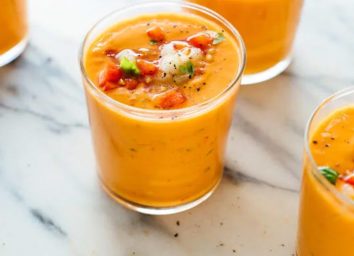Here's What Happens to Your Food When It Sits Out in the Sun

It's outdoor eating season, which means it's time for juicy cheeseburgers, hot dogs, grilled pineapple, and creamy potato salad. However, have you ever thought about when and how food may spoil if left out in the sun for too long? It's likely not the first thing you think of as you're mingling with relatives and friends at a beautiful park or in your backyard at a BBQ, but it can become a health issue if you're not careful, putting yourself and others at risk. To clue you in on some of the food safety issues that may arise, including how long food can sit out, we consulted with Meredith Carothers, the technical information specialist at the USDA's Food Safety and Inspection Service.
Here's all that you need to know to forgo the risk of foodborne illness and find out how long food can sit out in the sun.
What happens to your food if it sits out in the sun for too long? Why does this occur?
Grandma's legendary chicken salad may have been basking in the sun for too long. According to Carothers, leaving food out for too long even in room temperature can invite bacteria such as Staphylococcus aureus, Salmonella, and E. coli to grow, which could ultimately cause foodborne illness.
"Bacteria can multiply rapidly, doubling in number in as little as 20 minutes, if food is left out too long," she says. "There are some bacteria that, if allowed to multiply, produce toxins that cannot be killed by cooking or reheating."
Reheating leftover food from an outdoor picnic or BBQ in a microwave will not guarantee safety from this bacteria, either.
How long does food have to sit out in the sun for it to spoil?
Carothers says that perishable food, or food that requires refrigeration, should not sit out at room temperature for more than two hours, as bacteria can begin to grow and put you at risk of foodborne illness. However, in the summertime when it's often 90°F and above, perishable food should be removed from the heat after just one hour.
Are there physical signs to tell you that your food is no longer safe to eat after being exposed to heat and sunlight?
"In terms of foodborne illness bacteria, you can't see, smell, or taste harmful bacteria that may cause illness," says Carothers. "If you leave an item out in the sunlight for two hours, or one hour if above 90°F, there is the potential for bacteria growth at dangerous levels, and the product would no longer be considered safe."
What kind of bacteria can grow on food that has spoiled from the heat? At what temperature do bacteria thrive in?
"Common foodborne illness bacteria, such as Staphylococcus aureus, Salmonella Enteritidis, Escherichia coli O157: H7, and Campylobacter will multiply rapidly between temperatures of 40°F and 140°F," she says.
What are some ways you can prevent your food from becoming unsafe to eat?
Carothers provides a list of helpful tips.
- Make sure your cooler is cold. Ensuring your cooler is fully stocked with ice or frozen gel packs can help to keep perishable foods cold. Pack perishable foods directly from the refrigerator or freezer into the cooler.
- Pack raw meat at the bottom of the cooler. Be sure to keep raw meat and poultry at the very bottom of the cooler, wrapped separately from cooked foods and foods meant to be eaten raw, such as fruits. Meat and poultry items may be packed while still frozen, keeping them colder longer.
- Pack beverages and perishable foods in separate coolers. The beverage cooler may be opened frequently, causing the temperature inside of the cooler to fluctuate and become unsafe for perishable foods, so it's best to keep them separated in different coolers.
- Pack the cooler to the brim. A full cooler will maintain its cold temperature longer than one that is partially filled. If the cooler is only partially filled, pack the remaining space with more ice or cooling packs. For long trips, take along two coolers: one for immediate food needs, such as lunch, drinks, or snacks for the car trip, and the other for perishable foods to be used later.
- Limit the number of times the cooler is opened. Open and close the lid quickly to keep hot air out.
- Keep the cooler in the shade at all times. While driving, keep the cooler in the coolest part of the car, and once outside, place it in the shade or out of the sun whenever possible.
- To keep foods cold, try an ice bath. Ice baths are a great option for keeping cold items cold at a cookout, outdoor party, or a picnic. To prepare an ice bath, fill a pan or bowl with ice and place a container with food on top so it is resting on the ice. It is important to monitor the ice bath by draining the water as ice melts and replacing the ice as needed.








